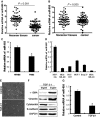miR-655 suppresses epithelial-to-mesenchymal transition by targeting Prrx1 in triple-negative breast cancer
- PMID: 26820102
- PMCID: PMC4831358
- DOI: 10.1111/jcmm.12770
miR-655 suppresses epithelial-to-mesenchymal transition by targeting Prrx1 in triple-negative breast cancer
Retraction in
-
Retraction: miR-655 suppresses epithelial-to-mesenchymal transition by targeting Prrx1 in triple-negative breast cancer.J Cell Mol Med. 2024 Apr;28(8):e18314. doi: 10.1111/jcmm.18314. J Cell Mol Med. 2024. PMID: 38655709 Free PMC article.
Abstract
Triple-negative breast cancer (TNBC) is a highly aggressive breast cancer subtype that lacks effective targeted therapies. The epithelial-to-mesenchymal transition (EMT) is a key contributor in the metastatic process. In this study, we found that miR-655 was down-regulated in TNBC, and its expression levels were associated with molecular-based classification and lymph node metastasis in breast cancer. These findings led us to hypothesize that miR-655 overexpression may inhibit EMT and its associated traits of TNBC. Ectopic expression of miR-655 not only induced the up-regulation of cytokeratin and decreased vimentin expression but also suppressed migration and invasion of mesenchymal-like cancer cells accompanied by a morphological shift towards the epithelial phenotype. In addition, we found that miR-655 was negatively correlated with Prrx1 in cell lines and clinical samples. Overexpression of miR-655 significantly suppressed Prrx1, as demonstrated by Prrx1 3'-untranslated region luciferase report assay. Our study demonstrated that miR-655 inhibits the acquisition of the EMT phenotype in TNBC by down-regulating Prrx1, thereby inhibiting cell migration and invasion during cancer progression.
Keywords: Prrx1; epithelial-to-mesenchymal transition; miR-655; triple-negative breast cancer.
© 2016 The Authors. Journal of Cellular and Molecular Medicine published by John Wiley & Sons Ltd and Foundation for Cellular and Molecular Medicine.
Figures







Similar articles
-
MiR-212-5p Suppresses the Epithelial-Mesenchymal Transition in Triple-Negative Breast Cancer by Targeting Prrx2.Cell Physiol Biochem. 2017;44(5):1785-1795. doi: 10.1159/000485785. Epub 2017 Dec 6. Cell Physiol Biochem. 2017. PMID: 29216628
-
miR-300 inhibits epithelial to mesenchymal transition and metastasis by targeting Twist in human epithelial cancer.Mol Cancer. 2014 May 24;13:121. doi: 10.1186/1476-4598-13-121. Mol Cancer. 2014. PMID: 24885626 Free PMC article.
-
miR-3178 inhibits cell proliferation and metastasis by targeting Notch1 in triple-negative breast cancer.Cell Death Dis. 2018 Oct 17;9(11):1059. doi: 10.1038/s41419-018-1091-y. Cell Death Dis. 2018. PMID: 30333478 Free PMC article.
-
MDIG in Breast Cancer Progression and Metastasis.Adv Exp Med Biol. 2024;1465:1-14. doi: 10.1007/978-3-031-66686-5_1. Adv Exp Med Biol. 2024. PMID: 39586990 Review.
-
Role of Nischarin in the pathology of diseases: a special emphasis on breast cancer.Oncogene. 2022 Feb;41(8):1079-1086. doi: 10.1038/s41388-021-02150-4. Epub 2022 Jan 22. Oncogene. 2022. PMID: 35064214 Review.
Cited by
-
The Role of MicroRNA in the Regulation of Tumor Epithelial-Mesenchymal Transition.Cells. 2022 Jun 21;11(13):1981. doi: 10.3390/cells11131981. Cells. 2022. PMID: 35805066 Free PMC article. Review.
-
MiRNA and LncRNA as Potential Biomarkers in Triple-Negative Breast Cancer: A Review.Front Oncol. 2020 Nov 20;10:526850. doi: 10.3389/fonc.2020.526850. eCollection 2020. Front Oncol. 2020. PMID: 33330019 Free PMC article. Review.
-
COX-2 induces oncogenic micro RNA miR655 in human breast cancer.Sci Rep. 2018 Jan 10;8(1):327. doi: 10.1038/s41598-017-18612-3. Sci Rep. 2018. PMID: 29321644 Free PMC article.
-
The Regulatory Role of PRRX1 in Cancer Epithelial-Mesenchymal Transition.Onco Targets Ther. 2021 Jul 16;14:4223-4229. doi: 10.2147/OTT.S316102. eCollection 2021. Onco Targets Ther. 2021. PMID: 34295164 Free PMC article. Review.
-
PTIP promotes recurrence and metastasis of hepatocellular carcinoma by regulating epithelial-mesenchymal transition.Oncotarget. 2017 Mar 22;8(35):58184-58198. doi: 10.18632/oncotarget.16436. eCollection 2017 Aug 29. Oncotarget. 2017. PMID: 28938547 Free PMC article.
References
-
- Guo W, Wang C, Guo Y, et al RASSF5A, a candidate tumor suppressor, is epigenetically inactivated in esophageal squamous cell carcinoma. Clin Exp Metastasis. 2015; 32: 83–98. - PubMed
-
- Xu XT, Tao ZZ, Song QB, et al SUZ12 RNA interference inhibits the invasion of gastric carcinoma cells. Hepatogastroenterology. 2014; 61: 2416–20. - PubMed
Publication types
MeSH terms
Substances
LinkOut - more resources
Full Text Sources
Other Literature Sources
Medical

